Folding paper can serve a greater purpose than just the ability to reduce a page’s overall size. By carefully selecting a few folds, your brochure or direct mail piece can quickly become an engaging piece of marketing. To provide you with a better understanding of what can be accomplished, we have compiled some examples below of the various types of folding techniques.

Folding paper can be categorised into two main groups: parallel folds and combination folds. Parallel folds involve folding the paper vertically in a manner that the folds run parallel to each other, like a roll fold. Combination folds combine two sets of parallel folds at right angles, like a half fold then tri fold.
Once the fundamentals of folding are understood, you can expand your creativity by incorporating short or Asymmetric folds, making the opportunities for producing uniquely creative and engaging projects limitless.
Expanding the possibilities even further are short folds, which are folds that are not folded all the way to the other edge. Most of the common folds above can have shortened panels to any length. These folds can be on the inside or the outside, top or bottom.





